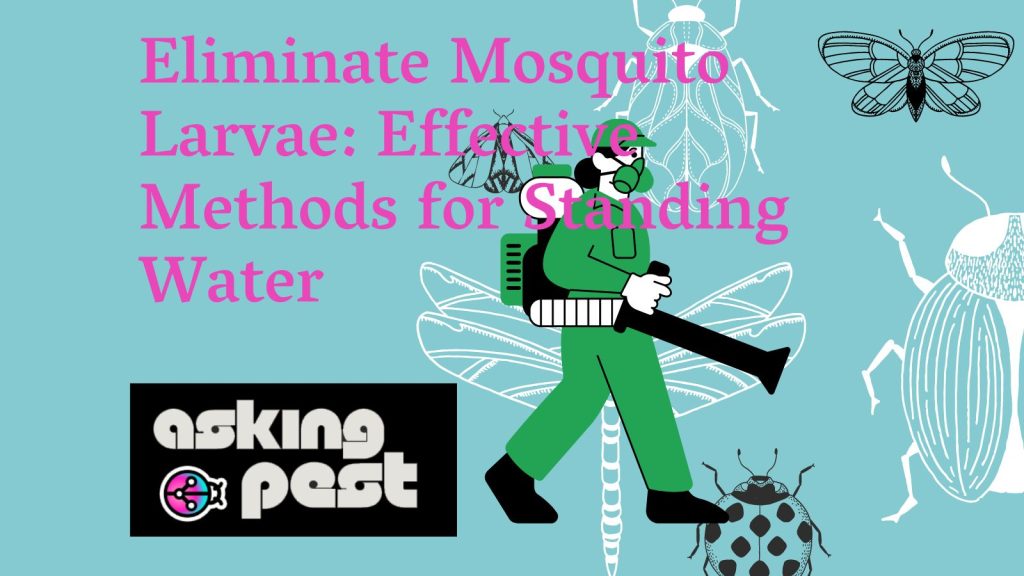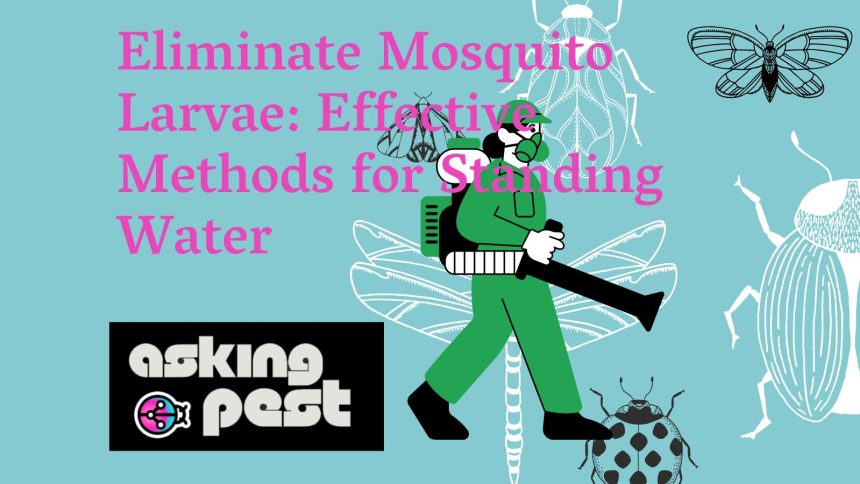The phrase “what kills mosquito larvae in standing water” refers to various substances or methods that eliminate immature mosquitoes in stagnant bodies of water. One common and effective solution is the use of larvicides, chemical agents specifically designed to target and kill mosquito larvae.
Larvicides play a crucial role in reducing mosquito populations and preventing the spread of mosquito-borne diseases. By eliminating larvae in standing water sources, larvicides contribute to public health and well-being. One significant historical development in this field was the discovery of Bacillus thuringiensis israelensis (Bti), a naturally occurring bacterium that is highly toxic to mosquito larvae.
This article will delve deeper into the different methods used to combat mosquito larvae in standing water, exploring their effectiveness, potential drawbacks, and best practices for their application. Understanding the available options and their implications can empower individuals and organizations to make informed decisions and contribute to the reduction of mosquito-borne diseases.
What Kills Mosquito Larvae in Standing Water

Identifying the key aspects of “what kills mosquito larvae in standing water” is essential for understanding how to manage and control mosquito populations. These aspects include:
- Larvicides
- Biological control
- Physical methods
- Chemical control
- Environmental management
- Integrated pest management
- Surveillance
- Public education
These aspects encompass various dimensions, including the use of chemical and biological agents, physical barriers, environmental modifications, and community involvement. A comprehensive approach that incorporates multiple aspects is crucial for effective mosquito control and the prevention of mosquito-borne diseases.
Larvicides
Larvicides are substances or agents used to kill mosquito larvae in standing water. They are a critical component of mosquito control programs, particularly in areas where mosquito-borne diseases are prevalent.
- Chemical larvicides
Chemical larvicides are synthetic compounds designed to target and kill mosquito larvae. They can be applied directly to standing water sources, such as ponds, ditches, and containers. - Biological larvicides
Biological larvicides are naturally occurring substances or organisms that are toxic to mosquito larvae. Examples include Bacillus thuringiensis israelensis (Bti), a bacterium that specifically targets and kills mosquito larvae. - Insect growth regulators (IGRs)
IGRs are substances that interfere with the growth and development of mosquito larvae. They can prevent larvae from molting into adults or cause them to develop into non-viable adults. - Oils and surface films
Oils and surface films can be applied to standing water sources to create a barrier that prevents mosquito larvae from accessing the water surface to breathe.
Larvicides play a vital role in reducing mosquito populations and preventing mosquito-borne diseases. By targeting and killing mosquito larvae before they can develop into adults, larvicides help to break the mosquito life cycle and reduce the risk of transmission of diseases such as malaria, dengue, and yellow fever.
Biological control
Biological control is an essential aspect of mosquito larval control, utilizing natural enemies and ecological processes to suppress mosquito populations without relying solely on chemical interventions. It involves the introduction, augmentation, or manipulation of natural enemies, such as predators, parasites, and pathogens, to target and reduce mosquito larvae in standing water.
- Predators
Predators such as fish, amphibians, and aquatic insects feed on mosquito larvae, reducing their numbers. For instance, the mosquito fish (Gambusia affinis) is commonly introduced into mosquito-infested water bodies to prey on mosquito larvae. - Parasites
Parasites, such as nematodes and microsporidia, can infect and kill mosquito larvae. For example, the nematode Romanomermis culicivorax specifically targets and parasitizes mosquito larvae. - Pathogens
Pathogens, including bacteria, fungi, and viruses, can cause diseases in mosquito larvae, leading to their death. Bacillus thuringiensis israelensis (Bti) is a widely used bacterial larvicide that specifically targets and kills mosquito larvae. - Habitat modification
Modifying the habitat to make it less suitable for mosquito breeding can also be considered a form of biological control. For instance, removing vegetation and debris from water bodies can reduce the availability of breeding sites for mosquitoes.
In conclusion, biological control offers a sustainable and environmentally friendly approach to managing mosquito larvae in standing water. By harnessing the natural abilities of predators, parasites, pathogens, and habitat modifications, biological control can effectively suppress mosquito populations, reducing the risk of mosquito-borne diseases.
Physical methods
Physical methods are an essential component of mosquito larval control, employing physical barriers and interventions to prevent mosquito larvae from developing and thriving in standing water. These methods are often environmentally friendly and can be implemented in various settings.
- Source reduction Source reduction involves eliminating or modifying potential mosquito breeding sites by removing standing water sources, such as clogged gutters, old tires, and birdbaths. This method helps to prevent mosquitoes from laying eggs and reduces larval populations.
- Water management Water management techniques, such as draining or flushing standing water, can effectively eliminate mosquito larvae. Draining stagnant pools and ensuring proper water flow in irrigation systems helps to prevent mosquito breeding and reduce larval habitats.
- Physical barriers Physical barriers, such as mosquito netting and screens, can be used to prevent mosquitoes from accessing water bodies and laying eggs. These barriers can be installed around water storage containers, ponds, and other potential breeding sites.
- Larval traps Larval traps are devices designed to attract and trap mosquito larvae. These traps can be baited with organic materials or pheromones, and once larvae enter the traps, they are unable to escape.
Physical methods offer a safe and effective approach to mosquito larval control. By eliminating breeding sites, preventing mosquito access to water, and trapping larvae, physical methods can significantly reduce mosquito populations and the risk of mosquito-borne diseases.
Chemical control
Chemical control is an effective method for eliminating mosquito larvae in standing water, offering rapid and targeted action to reduce mosquito populations and mitigate the risk of mosquito-borne diseases. Chemical larvicides are specifically designed to target and kill mosquito larvae, providing a potent tool for mosquito control programs.
- Synthetic larvicides Synthetic larvicides are man-made chemical compounds specifically developed to kill mosquito larvae. They are typically applied directly to standing water sources, such as ponds, ditches, and containers, and can provide long-lasting control.
- Insect growth regulators (IGRs) Insect growth regulators (IGRs) are chemical compounds that interfere with the growth and development of mosquito larvae, preventing them from molting into adults. IGRs can be applied to standing water sources to target mosquito larvae at specific stages of their life cycle.
- Oils and surface films Oils and surface films can be applied to standing water sources to create a barrier that prevents mosquito larvae from accessing the water surface to breathe. These substances can be particularly effective in treating small water bodies, such as containers and bird baths.
- Biopesticides Biopesticides are naturally occurring substances or organisms that have pesticidal properties and can be used to control mosquito larvae. Examples include Bacillus thuringiensis israelensis (Bti), a bacterium that specifically targets and kills mosquito larvae.
Chemical control methods offer a powerful approach to reducing mosquito populations and preventing the spread of mosquito-borne diseases. By utilizing chemical larvicides and other chemical control agents, public health officials and mosquito control professionals can effectively target and eliminate mosquito larvae in standing water, contributing to the protection of human health and well-being.
Environmental management
Environmental management’s role in eliminating mosquito larvae in standing water is crucial for mitigating the spread of mosquito-borne diseases and safeguarding public health. A well-managed environment reduces mosquito breeding habitats, consequently limiting larval populations and disease transmission.
One significant aspect of environmental management is the identification and elimination of mosquito breeding sites. This involves measures like eliminating standing water sources, clearing clogged gutters, and removing discarded tires and containers where water can accumulate. By reducing the availability of stagnant water, environmental management effectively prevents mosquito larvae from thriving and developing into adults.
Furthermore, environmental management encompasses strategies to alter mosquito habitats, rendering them less favorable for breeding. This can include introducing natural predators like fish or dragonflies into water bodies, promoting vegetation that repels mosquitoes, and implementing water flow management techniques to prevent stagnation. These measures disrupt the mosquito life cycle and further minimize larval populations.
In practical terms, environmental management plays a vital role in integrated mosquito control programs. By addressing the root causes of mosquito breeding, environmental management complements other control methods, such as larvicides and biological control, to achieve long-term and sustainable mosquito population reduction. This comprehensive approach enhances community health and well-being by reducing the incidence of mosquito-borne diseases.
Integrated pest management
Integrated pest management (IPM) is a comprehensive approach to managing pests, including mosquitoes, that emphasizes the use of multiple methods to achieve long-term, sustainable control. By combining biological, cultural, physical, and chemical control methods, IPM aims to minimize the reliance on chemical pesticides and mitigate the potential negative impacts on human health and the environment.
- Monitoring Monitoring involves regularly inspecting potential mosquito breeding sites to detect and assess larval populations. This information helps determine the need for control measures and guides decision-making.
- Source reduction Source reduction focuses on eliminating or modifying potential mosquito breeding sites by removing standing water sources, such as clogged gutters, old tires, and birdbaths.
- Biological control Biological control utilizes natural enemies, such as predators, parasites, and pathogens, to control mosquito larvae. This method involves the introduction, augmentation, or manipulation of these natural enemies to target and reduce mosquito populations.
- Chemical control Chemical control involves the use of larvicides and adulticides to kill mosquito larvae and adults. This method is often employed when other control measures are not sufficient or when rapid reduction of mosquito populations is necessary.
IPM provides a multifaceted approach to managing mosquito larvae in standing water, emphasizing long-term sustainability, environmental protection, and cost-effectiveness. By combining various control methods, IPM reduces the reliance on chemical pesticides, minimizes the risk of resistance development, and promotes ecological balance. This comprehensive approach contributes to the protection of public health and well-being by effectively controlling mosquito populations and mitigating the transmission of mosquito-borne diseases.
Surveillance
Surveillance plays a crucial role in the effective management of mosquito larvae in standing water, as it provides essential information for decision-making and targeted control measures. By monitoring mosquito populations and identifying potential breeding sites, surveillance enables public health officials to implement proactive and timely interventions to prevent the spread of mosquito-borne diseases.
Surveillance involves regular inspections of potential mosquito breeding sites, such as stagnant water bodies, containers, and vegetation. This monitoring helps to detect the presence of mosquito larvae, assess their abundance, and identify the species present. The data collected through surveillance informs the selection and implementation of appropriate control measures, such as larviciding, habitat modification, or biological control.
Real-life examples of surveillance in action include routine inspections of water storage containers in households and public places, monitoring of mosquito breeding sites in urban and rural areas, and targeted surveillance in response to disease outbreaks. The information gathered from these surveillance activities guides vector control programs, allowing for efficient resource allocation and timely interventions to prevent mosquito population growth and disease transmission.
In conclusion, surveillance is a critical component of effective mosquito larval control. It provides valuable information that enables public health officials to identify mosquito breeding sites, track population trends, and make informed decisions about control measures. By integrating surveillance into mosquito management programs, communities can proactively manage mosquito populations, reduce the risk of mosquito-borne diseases, and protect public health.
Public education
Public education is a crucial aspect of effective mosquito larval control in standing water, empowering communities to play an active role in reducing mosquito populations and preventing the spread of mosquito-borne diseases.
- Raising awareness Public education campaigns aim to raise awareness about the importance of mosquito control and the role of standing water in mosquito breeding. This includes educating the public on the risks associated with mosquito-borne diseases and the simple steps individuals can take to eliminate mosquito breeding sites around their homes and communities.
- Promoting best practices Public education also focuses on promoting best practices for mosquito control, such as regular removal of standing water from containers, proper disposal of tires and other potential breeding sites, and the use of mosquito repellents and bed nets. By sharing practical tips and techniques, public education empowers communities to take ownership of mosquito control and protect their health.
- Engaging community participation Community participation is essential for successful mosquito control programs. Public education campaigns can mobilize community members to participate in clean-up drives, distribute educational materials, and report mosquito breeding sites to local authorities. By fostering a sense of shared responsibility, public education fosters a collective effort to reduce mosquito populations and safeguard public health.
- Empowering local leaders Local leaders, such as community health workers and school teachers, play a vital role in educating their communities about mosquito control. Public education programs can provide these leaders with the knowledge and resources they need to effectively disseminate information and promote best practices within their communities.
In conclusion, public education is a multifaceted and essential component of mosquito larval control in standing water. It empowers communities with the knowledge, skills, and motivation to take an active role in preventing mosquito-borne diseases. By raising awareness, promoting best practices, engaging community participation, and empowering local leaders, public education contributes to sustainable and effective mosquito control, safeguarding public health and well-being.
Frequently Asked Questions about Mosquito Larvae Control in Standing Water
This section addresses common questions and clarifies aspects related to “what kills mosquito larvae in standing water.” It provides concise and informative answers to guide readers in their understanding and implementation of effective mosquito control measures.
Question 1: What is the most effective method to kill mosquito larvae in standing water?
Answer: The most effective method depends on the specific situation and resources available. Chemical larvicides provide rapid and targeted control, but biological control using predators or bacteria offers a more sustainable and environmentally friendly approach.
Question 2: Are there natural ways to kill mosquito larvae in standing water?
Answer: Yes, biological control agents such as fish, dragonflies, and mosquito-eating bacteria can effectively reduce mosquito larval populations. Additionally, introducing plants that repel mosquitoes or planting vegetation that absorbs standing water can help prevent breeding.
Question 3: How often should I treat standing water to prevent mosquito larvae?
Answer: The frequency of treatment depends on the type of larvicide used, environmental conditions, and mosquito breeding activity. Generally, it’s recommended to treat standing water sources every 7-14 days or as per the manufacturer’s instructions.
Question 4: Is it safe to use chemical larvicides in standing water near pets or children?
Answer: Some chemical larvicides may pose risks to pets or children if ingested or exposed directly. Always follow the manufacturer’s instructions carefully, use larvicides specifically labeled for standing water treatment, and take appropriate precautions to minimize exposure.
Question 5: What are some simple steps I can take to reduce mosquito breeding in my yard?
Answer: Regularly remove standing water from containers, bird baths, and clogged gutters; keep lawns mowed and vegetation trimmed; and install mosquito traps or use mosquito repellents to deter adult mosquitoes.
Question 6: What are the potential consequences of not controlling mosquito larvae in standing water?
Answer: Uncontrolled mosquito populations can lead to increased risk of mosquito-borne diseases, such as malaria, dengue, and Zika virus. These diseases can cause severe illness, disability, and even death.
In summary, understanding the various methods for killing mosquito larvae in standing water, considering the environmental and safety implications, and implementing a comprehensive approach to mosquito control are crucial for preventing mosquito-borne diseases and protecting public health.
To further delve into the topic, the next section will discuss best practices for implementing mosquito larval control measures in different settings, ensuring effectiveness and minimizing potential risks.
Tips to Effectively Kill Mosquito Larvae in Standing Water
Implementing practical measures to eliminate mosquito larvae in standing water is essential for preventing mosquito-borne diseases and safeguarding public health. Here are several detailed tips to guide your efforts:
Tip 1: Eliminate standing water sources
Regularly inspect your property and remove any containers or objects that can accumulate water, such as old tires, birdbaths, and clogged gutters.
Tip 2: Introduce natural predators
Encourage the presence of mosquito-eating predators like fish, dragonflies, and bats by creating habitats that attract them.
Tip 3: Use biological larvicides
Apply environmentally friendly larvicides based on naturally occurring bacteria, such as Bacillus thuringiensis israelensis (Bti), to target mosquito larvae specifically.
Tip 4: Install mosquito traps
Place mosquito traps around your property to attract and capture adult mosquitoes, reducing their population and preventing egg-laying.
Tip 5: Maintain proper water management
Ensure proper drainage and water flow in irrigation systems, ponds, and other water bodies to prevent mosquito breeding.
Tip 6: Use mosquito repellents and bed nets
When spending time outdoors or in areas with high mosquito activity, apply EPA-registered mosquito repellents and use bed nets to protect yourself from bites.
Tip 7: Educate your community
Share your knowledge and encourage your neighbors to adopt mosquito control measures to create a collective impact in reducing mosquito populations.
By following these tips and implementing a comprehensive approach to mosquito larval control, you can significantly reduce the risk of mosquito-borne diseases and create a healthier environment for your community.
The next section of this article will delve into the importance of sustained mosquito control efforts and provide guidance on how to maintain effective mosquito management programs over the long term.
Conclusion
This comprehensive exploration of “what kills mosquito larvae in standing water” has highlighted effective methods, including chemical larvicides, biological control agents, physical elimination, and environmental management. A key insight is that a multifaceted approach is crucial, as it allows for targeted control and reduces the risk of resistance development. Additionally, community involvement and public education are essential for sustained mosquito control efforts.
As we continue to face the challenge of mosquito-borne diseases, it is imperative that we prioritize mosquito larval control in standing water. By implementing integrated control measures, promoting community participation, and investing in research and innovation, we can safeguard public health and create a healthier future for all.









